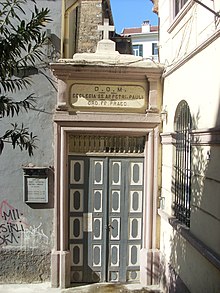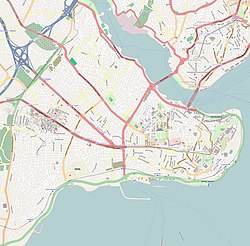Church of SS Peter and Paul, Istanbul
| Church of SS Peter and Paul | |
|---|---|
 The entrance to the courtyard: the church building is on the left side | |
 Church of SS Peter and Paul Location in Istanbul | |
| Location | Galata, Istanbul |
| Country | |
| Denomination | Roman Catholic |
| Architecture | |
| Architect(s) | Gaspare and Giuseppe Fossati |
| Groundbreaking | 1603-4 |
| Completed | 1843 |
SS Peter and Paul (Turkish: Sen Pier ve Sen Paul Kilisesi, Italian: Chiesa dei Santi Pietro e Paolo a Galata) is a Roman Catholic church in Istanbul, important for historical reasons. The church owns an icon of the Virgin of the Hodegetria type, which originally lay in a Dominican church in Caffa, Crimea.[1] The current building is a nineteenth-century (1841 to 1843) reconstruction of the Fossati brothers.[2]
Location[]
The church lies in Karaköy (ancient Galata) neighborhood of the district of Beyoğlu, Istanbul, Turkey. Its address is Galata Kulesi Sokak 44, Kuledibi.
History[]
After that in 1475 Sultan Mehmet II had converted the Dominican Church of San Paolo in Galata into a mosque, in 1476 the friars moved two hundred meters East,[3] always below the Galata Tower, in a house with land owned by Venetian noblemen Angelo Zaccaria.[2] In the building was enclosed a small chapel - used by nuns - dedicated to the Saints Peter and Paul. On 20 April 1535, the old Zaccaria ceded the house to the Dominicans against the monthly offer of a candle and the weekly celebration of a mass for the souls of himself and his parents.[2] In 1603-1604 the chapel was rebuilt as a larger church together with a monastery.[2] In 1608, a Firman of Sultan Ahmed III put the complex under the protection of the King of France, while at the same time the church got also a yearly subsidy from the Republic of Venice.[2]
In 1640, a large icon of the Hodegetria type (originally in Caffa) which belonged to the Dominican Church of S. Maria di Costantinopoli, located inside the walled city of Istanbul and in that year converted into a mosque, was moved here.[4] In 1660 the church and the monastery burned and, since the destruction had been total (except for the icon which could be rescued), according to the law the ground was returned to the Ottoman Government.[2] Despite that, thanks to the intercession of the European Powers, a new church could be built again in 1702.[2] Since 1706, after the Dominicans refused to deliver the Hodegetria Icon to Venice, the Republic quit paying the subsidy to the church.[2] Around those years, the Icon was partially repainted (the mantle of the Virgin appears now embroidered with the Fleurs-de-lis of France), so that only her face and chest are possibly original.[1] The complex burned again during the great fire of Galata in 1731, and was rebuilt with wood.[2] From 1841 to 1843 the Swiss-Italian brothers Gaspare and Giuseppe Fossati erected the present building.[2]
Together with Saint Anthony and Saint Mary Draperis, SS. Peter and Paul was one of the three Levantine parishes in Beyoğlu.[5] The parish jurisdiction extended over the lower part of the Galata neighborhood, a popular area which often became the first residence for European immigrants settling in the city.[5] Due to that, the parish's birth, wedding and death registers represent an invaluable source for the history of the recurring waves of immigration in the 18th and 19th century.[5] The church now serves the local Maltese community, with masses in Italian.[6]
Architecture[]
The church is built in the form of a basilica, with a four side altar.[7] The cupola over the choir is sky blue, studded with gold stars.[7] The church's rear wall is built into a section of Galata's old Genoese ramparts.[7] The church possesses several relics: those of Saint Renatus (found in the catacombs of Galata), and others of Saint Thomas, Saint Dominic and the Saints Peter and Paul.[1] The yard East of the church's entrance takes the form of a narrow alleyway enclosed by high walls which are covered with sculptures and inscribed gravestones, most of them in Italian.[1] More graves are contained in the church's crypt.[1]
References[]
- ^ Jump up to: a b c d e Mamboury (1953), p. 318
- ^ Jump up to: a b c d e f g h i j Mamboury (1953), p. 317
- ^ Janin (1953), p. 600
- ^ Müller-Wiener (1977), p. 188.
- ^ Jump up to: a b c Schmitt (2005)
- ^ "Catholic Churches". My merhaba. Archived from the original on 6 March 2014. Retrieved 23 March 2012.
- ^ Jump up to: a b c Eyewitness Travel Guides (1998). Istanbul. London: DK. p. 105. ISBN 0-7513-6881-4.
Sources[]
- Mamboury, Ernest (1953). The Tourists' Istanbul. Istanbul: Çituri Biraderler Basımevi.
- Janin, Raymond (1953). La Géographie Ecclésiastique de l'Empire Byzantin. 1. Part: Le Siège de Constantinople et le Patriarcat Oecuménique. 3rd Vol. : Les Églises et les Monastères (in French). Paris: Institut Français d'Etudes Byzantines.
- Müller-Wiener, Wolfgang (1977). Bildlexikon Zur Topographie Istanbuls: Byzantion, Konstantinupolis, Istanbul Bis Zum Beginn D. 17 Jh (in German). Tübingen: Wasmuth. ISBN 978-3-8030-1022-3.
- Schmitt, Oliver Jens (2005). Levantiner. Lebenswelten und Identitäten einer ethnokonfessionellen Gruppe im osmanischen Reich im langen 19. Jahrhundert (in German). Munich: Oldenbourg Verlag. ISBN 978-3-486-57713-6.
External links[]
- "Church of SS Peter and Paul". katolikkilisesi.org. Archived from the original on 2014-07-07. Retrieved 2014-06-21.
- Saint Pierre ve Saint Paul Kilisesi (İstanbul) (in Turkish)
- Church of SS Peter and Paul
- Roman Catholic churches in Istanbul
- Roman Catholic churches completed in 1843
- 19th-century Roman Catholic church buildings in Turkey
- Beyoğlu
- 1843 establishments in the Ottoman Empire
